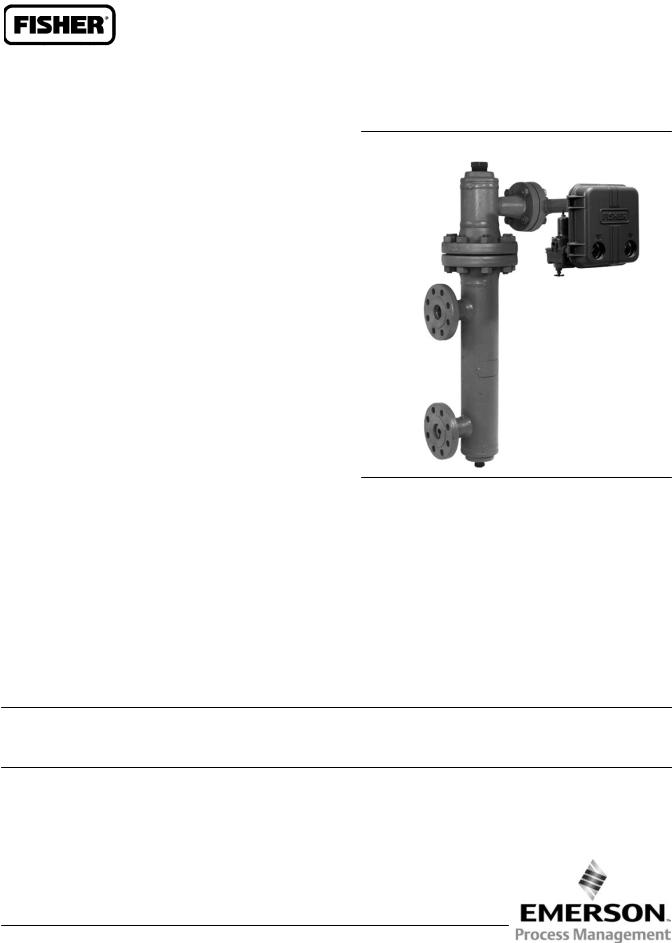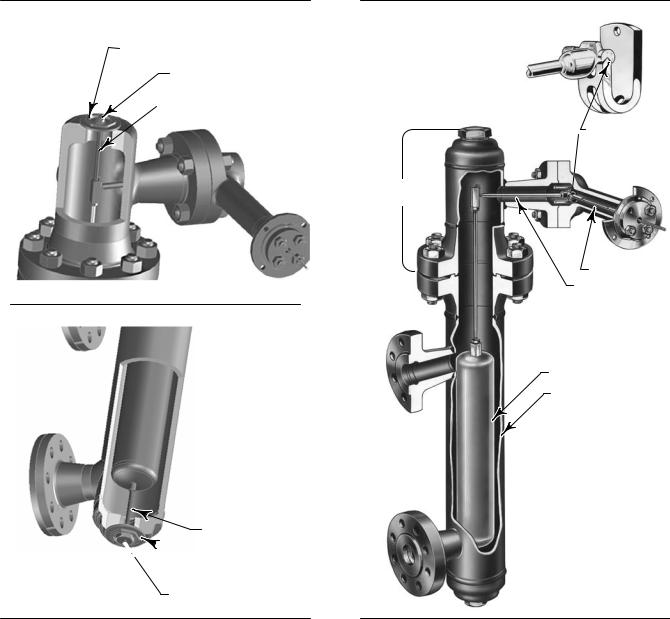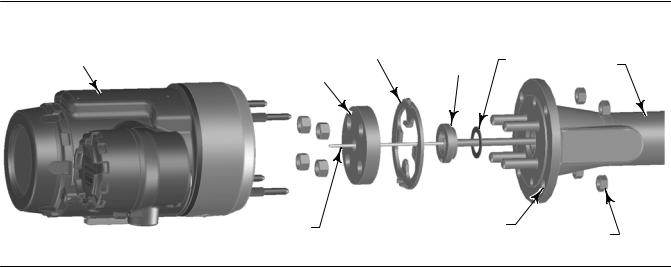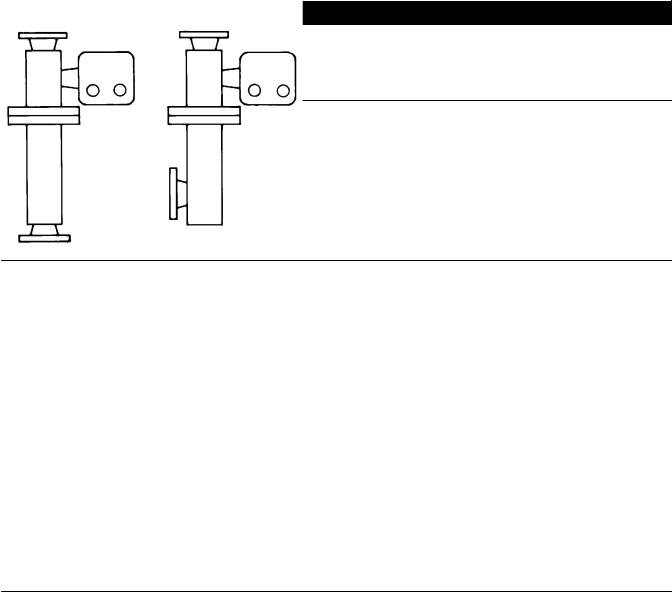Emerson Fisher 249, Fisher 249B, Fisher 249BF, Fisher 249C, Fisher 249K Instruction Manual
...
Instruction Manual |
249 Caged Sensors |
D200099X012 |
August 2014 |
|
|
Fisherr 249 Caged Displacer Sensors
Contents |
|
Introduction . . . . . . . . . . . . . . . . . . . . . . . . . . . . . . . . . |
1 |
Scope of Manual . . . . . . . . . . . . . . . . . . . . . . . . . . . . . |
1 |
Description . . . . . . . . . . . . . . . . . . . . . . . . . . . . . . . . . |
2 |
Type Number Description . . . . . . . . . . . . . . . . . . . . . |
3 |
Educational Services . . . . . . . . . . . . . . . . . . . . . . . . . |
4 |
Maintenance . . . . . . . . . . . . . . . . . . . . . . . . . . . . . . . . . |
4 |
Cleaning the Cage . . . . . . . . . . . . . . . . . . . . . . . . . . . |
5 |
Removing the Displacer and Stem . . . . . . . . . . . . . . |
6 |
Replacing the Displacer, Cotter Spring, Stem |
|
End Piece, and Displacer Spud . . . . . . . . . . . . . . . |
7 |
Replacing the Displacer Rod/Driver Assembly . . . . |
8 |
Replacing the Torque Tube . . . . . . . . . . . . . . . . . . . . |
9 |
Changing Cage Head Position . . . . . . . . . . . . . . . . |
10 |
Replacing the Torque Tube Arm and |
|
Changing the Mounting . . . . . . . . . . . . . . . . . . . |
11 |
Simulation of Process Conditions for Calibration |
|
of Fisher Level Controllers and Transmitters . . . . |
12 |
Related Documents . . . . . . . . . . . . . . . . . . . . . . . . . . |
12 |
Parts Ordering . . . . . . . . . . . . . . . . . . . . . . . . . . . . . . . |
12 |
Parts Kits . . . . . . . . . . . . . . . . . . . . . . . . . . . . . . . . . . . |
13 |
Parts List . . . . . . . . . . . . . . . . . . . . . . . . . . . . . . . . . . . |
13 |
Figure 1. Fisher 249B Sensor with 2500 Controller
W3121 3
Introduction
Scope of Manual
This instruction manual includes maintenance and parts ordering information for 249 caged sensors.
Although a 249 sensor is usually shipped with attached controller or transmitter, this manual does not include operation, installation, calibration, maintenance, and parts ordering information for the controller/transmitter or for the complete unit. For this information, refer to the appropriate controller/transmitter instruction manual.
Note
Caged sensors have a rod and block shipping lock installed on each end of the displacer to protect the displacer in shipping, as shown in figure 2. Remove these parts before installing the sensor to allow the displacer to function properly.
Do not install, operate or maintain a 249 sensor without being fully trained and qualified in valve, actuator, and accessory installation, operation, and maintenance. To avoid personal injury or property damage, it is important to
www.Fisher.com

249 Caged Sensors |
Instruction Manual |
August 2014 |
D200099X012 |
|
|
carefully read, understand and follow all the contents of this manual, including all safety cautions and warnings. If you have any questions about these instructions, contact your Emerson Process Management sales office before proceeding.
Description
249 sensors are designed to measure liquid level, interface level, or density/specific gravity inside a vessel.
A torque tube assembly (figure 3) and displacer provide an indication of liquid level, interface level, or density/specific gravity. The torque tube assembly consists of a hollow torque tube with a shaft welded inside it at one end and protruding from it at the other end.
Figure 2. Rod and Block Shipping Lock |
Figure 3. Typical Caged Displacer |
||
SHIPPING BLOCK |
|
||
|
|
LOCK NUT |
|
|
|
SHIPPING STOP ROD |
W1800-1 |
|
|
||
|
|
|
|
KNIFE EDGE
BEARING
ROTATABLE
HEAD
TORQUE TUBE
DISPLACER ROD
X1114
DISPLACER
CAGE
SHIPPING STOP ROD
X1113 
 SHIPPING BLOCK
SHIPPING BLOCK
LOCK NUT
W2141-1
2

Instruction Manual |
249 Caged Sensors |
D200099X012 |
August 2014 |
|
|
The unconnected end of the tube is sealed by a gasket and clamped rigidly to the torque tube arm, permitting the protruding end of the shaft to twist and therefore transmit rotary motion. This allows the interior of the torque tube to remain at atmospheric pressure, thus eliminating packing and the disadvantages of packing friction.
The displacer always exerts a downward force on one end of the displacer rod. The other end of the displacer rod rests on the knife edge of the driver bearing. A keyed shaft on the bearing end of the displacer rod fits into a socket on the outside of the welded end of the torque tube assembly.
A change in liquid level, interface level, or density/specific gravity buoys up the displacer by a force equal to the weight of the liquid displaced. Corresponding vertical movement of the displacer results in angular movement of the displacer rod around the knife edge. Since the torque tube assembly is a torsional spring which supports the displacer and determines the amount of movement of the displacer rod for a given displacement change, it will twist a specific amount for each increment of buoyancy change. This rotation is brought through the torque tube arm by the protruding rotary shaft. A controller or transmitter attached to the end of the rotary shaft converts the rotary motion into varying pneumatic or electric signals. Figure 4 shows how the controller or transmitter mounts on the torque tube arm.
Unless otherwise noted, all NACE references are to NACE MR0175-2002.
Figure 4. Torque Tube Arm Exploded View Showing Controller or Transmitter Mounting
CONTROLLER OR TRANSMITTER |
|
|
|
POSITIONING |
|
|
|
||||
(DLC3010/DLC3020f |
|
|
|
|
|
TORQUE |
|||||
|
|
|
PLATE |
|
|
|
GASKET |
||||
SHOWN) |
|
|
|
|
|
|
OUTER |
|
TUBE ARM |
||
|
|
|
|
|
|
|
|
||||
|
|
RETAINING |
|
|
|
|
|||||
|
|
|
|
|
TUBE END |
|
|
|
|||
|
|
|
FLANGE |
|
|
|
|
|
|
|
|
|
|
|
|
|
|
|
|
|
|
|
|
ROTARY SHAFT
GE51212
MOUNTING HOLES ACCEPT FOUR STUDS OR CAP SCREWS DEPENDING ON CONTROLLER OR TRANSMITTER
HEX NUTS OR CAP SCREWS DEPENDING ON
CONTROLLER OR TRANSMITTER
Type Number Description
D 249—CL125 or 250 cast iron cage with screwed or flanged connections.
D 249B—CL150, 300, or 600 steel cage with screwed or flanged connections.
D 249BF—CL150, 300, or 600 cast steel or stainless steel cage with flanged connections only. Available from Emerson Process Management in Europe only.
D 249C—CL150, 300, or 600 stainless steel cage with screwed or flanged connections.
D 249K—CL900 or 1500 steel cage with flanged connections only.
D 249L—CL2500 steel cage with flanged connections only.
The cage head on all of the 249 constructions may be rotated to any of the eight alternate positions shown in figure 7. Connection sizes are either NPS 1 1/2 or 2.
3

249 Caged Sensors |
Instruction Manual |
August 2014 |
D200099X012 |
|
|
The Parts List section shows some 249 sizes by construction, standard displacer lengths, and standard materials and table 1 contains displacer and torque tube materials. However, 249 parts are available in a wide variety of materials of construction, part dimensions, and other specifications. Contact your Emerson Process Management sales office for assistance in selection of specific materials, dimensions, and specifications.
Table 1. Displacer and Torque Tube Materials
Part |
Standard Material |
Other Materials |
|
Displacer |
304 Stainless Steel |
316 Stainless Steel, N10276, N04400, Plastic, and Special Alloys |
|
|
|
|
|
Displacer Stem, Driver Bearing, |
316 Stainless Steel |
N10276, N04400, other Austenitic Stainless Steels, and Special Alloys |
|
Displacer Rod and Driver |
|||
|
|
||
|
|
|
|
Torque Tube |
N05500(1) |
316 Stainless Steel, N06600, N10276 |
1. N05500 is not recommended for spring applications above 232_C (450_F). Contact your Emerson Process Management sales office or application engineer if temperatures exceeding this limit are required.
Educational Services
For information on available courses for 249 displacer sensors, as well as a variety of other products, contact:
Emerson Process Management Educational Services, Registration
Phone: +1-641-754-3771 or +1800-338-8158 e mail: education@emerson.com http://www.emersonprocess.com/education
Maintenance
Sensor parts are subject to normal wear and must be inspected and replaced as necessary. The frequency of inspection and replacement depends upon the severity of service conditions.

 WARNING
WARNING
Always wear protective clothing, gloves, and eyewear when performing any installation operations to avoid personal injury.
Avoid personal injury or property damage resulting from the sudden release of pressure. Before performing any maintenance procedure:
D Relieve any process pressure in the vessel where the 249 sensor is installed.
D Drain the process liquid from the vessel.
D Shut off any electrical or pneumatic input to the controller or transmitter attached to the 249 sensor and vent any pneumatic supply pressure.
D Use caution when loosening flange bolting (key 22) or pipe plugs (key 17, 26, or 27).
D Remove the controller or transmitter from the torque tube arm (key 3).
Before continuing with any maintenance procedure, be sure the cage (key 1) is also free of process pressure and/or liquid. Use caution when loosening flange bolting (key 22) or pipe plugs (key 17, 26, or 27).
Before performing any maintenance procedure requiring the handling of the displacer, inspect the displacer (key 10) to make sure process pressure or liquids have not penetrated the displacer.
4

Instruction Manual |
249 Caged Sensors |
D200099X012 |
August 2014 |
|
|
The displacer in this unit is a sealed container. If penetrated by process pressure or liquid, the displacer may hold pressure or hazardous liquid for an extended period. A displacer that has been penetrated by process pressure or liquid may contain:
D pressure as a result of being in a pressurized vessel
D liquid that becomes pressurized due to a change in temperature
D liquid that is flammable, hazardous or corrosive
Sudden release of pressure, contact with hazardous liquid, fire, or explosion, which might result in personal injury or property damage, can occur if a displacer that is retaining pressure or process liquid is punctured, subjected to heat, or repaired.
Handle the displacer with care. Consider the characteristics of the specific process liquid in use.
Check with your process or safety engineer for any additional measures that must be taken to protect against process media.
Note
Except for gaskets (keys 13 and 14), trouble symptoms peculiar to specific parts are discussed in the following sections. Each section is specific to these parts. Regardless of location, gasket failure is indicated by leakage in the gasket area. Every time a gasket is removed, replace it with a new one upon reassembly.
The procedures below apply to all sensor types except where indicated. Key numbers used are shown in the following illustrations:
249—figure 8
249B—figure 9
249C—figure 10
249K—figure 11
249L—figure 12
Cleaning the Cage
Process residue buildup in the bottom of the cage (key 1) or at the connections may restrict flow in and out of the cage or interfere with displacer motion. Remove the cage to clean out process residue buildup.
1.Before starting any maintenance procedure, be sure the following safety actions have been completed.
D Relieve process pressure in the vessel where the 249 sensor is installed.
D Drain the process liquid from the vessel.
D Shut off any electrical or pneumatic input to the controller or transmitter attached to the 249 sensor and vent any pneumatic supply pressure. Remove the controller or transmitter from the torque tube arm (key 3). Take care not to damage the torque tube assembly (key 9) inside the torque tube arm.
D Be sure the cage is also free of process pressure and/or liquid. Use caution when loosening flange bolting (key 22) or pipe plugs (keys 17, 26, or 27).
D Be sure process pressure or liquids have not penetrated the displacer (key 10).
2.Properly support the cage head (key 2) and the torque tube arm. Remove the cap screws or stud bolts (key 21) and hex nuts (key 22) that hold the cage head to the cage.
5

249 Caged Sensors |
Instruction Manual |
August 2014 |
D200099X012 |
|
|
CAUTION
When removing a sensor from a cage, the displacer may remain attached to the displacer rod and be lifted out with the cage head when the cage head is removed. If separating the displacer and displacer rod before removing the cage head, remove the cotter spring (key 11).
Be careful not to let the displacer slip and drop into the bottom of the cage, as displacer damage could result.
3.Carefully remove the cage head and lift out the displacer.
4.A style 1 or 4 (screwed or flanged) cage must be disconnected at the lower connection and the liquid damper
(key 29) removed. Remove the damper by prying it out of a flanged connection or by unscrewing it from a screwed connection with a 1/2 inch hex (Allen) wrench. If necessary, completely remove the style 4 cage from the vessel.
5.For complete drainage and cleaning of a cage with style 2 or 3 (screwed or flanged) connections (figure 5), remove the pipe plug (keys 17 or 26) from the bottom of the cage. Remove the liquid damper (key 29). If necessary, completely remove the cage from the vessel.
Figure 5. Cage Connection Styles
STYLE 1: TOP |
STYLE 2: TOP |
STYLE 3: UPPER |
STYLE 4: UPPER |
|
|
AND LOWER SIDE |
SIDE AND BOTTOM |
SCREWED: S1 |
SCREWED: S2 |
SCREWED: S3 |
SCREWED: S4 |
FLANGED: F1 |
FLANGED: F2 |
FLANGED: F3 |
FLANGED: F4 |
A1271-2
6.Use appropriate cleaning techniques, tools, and solutions. After cleaning the cage, install the liquid damper and reconnect the cage to the vessel. Install the cage head and controller/transmitter. Properly calibrate the controller/transmitter following the procedures given in the controller/transmitter instruction manual.
Removing the Displacer and Stem
The displacer (key 10) is a sealed container. If the displacer has been penetrated by process pressure or liquid, it may hold pressure or hazardous liquid for an extended period.
Process residue buildup on the displacer and stem (key 24) may change displacer weight or displacement. A bent stem or a dented or corroded displacer can impair performance.
If the displacer rests against the travel stop, appears to be overweight, or causes output drift or other output inaccuracies, it may have been penetrated by process pressure or liquid. Such a displacer may contain pressure
6
